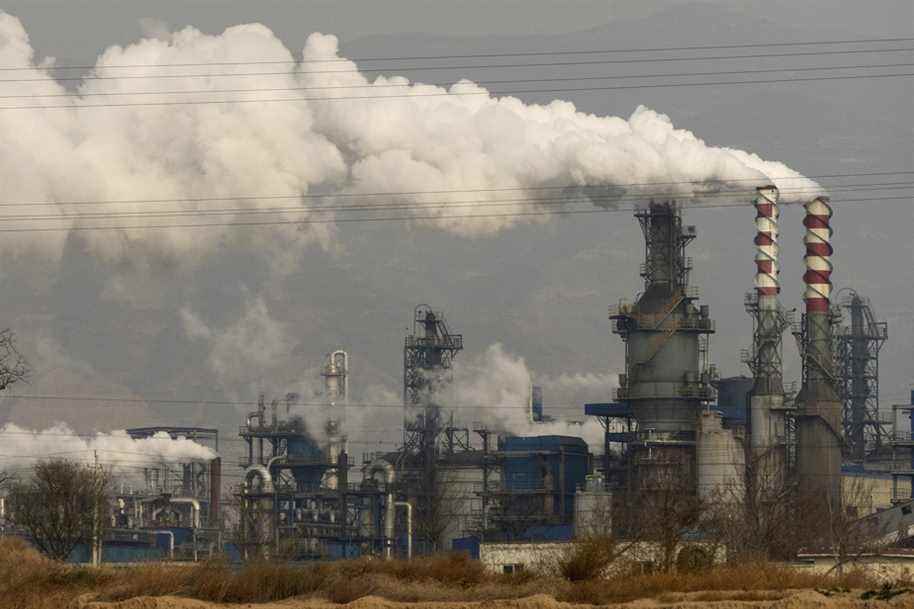Limiting global temperature rise to 1.5°C is still possible if global greenhouse gas (GHG) emissions peak by 2025 at the latest, but humanity is not yet on track to do so. achieve, warns the Intergovernmental Panel on Climate Change (IPCC).
Posted at 11:05 a.m.
Updated at 11:23 a.m.
Current emissions would also need to be halved by 2030 to meet the Paris Climate Agreement target, says the organization’s latest report, released on Monday, which focuses on ways to mitigate global warming.
However, the projected emissions of carbon dioxide (CO2) from existing and currently planned fossil fuel infrastructure exceed the not-to-exceed total to limit the rise to 1.5°C, and lead instead to a 2°C rise, observes the IPCC.
The report somehow underlines that any new project would reduce the chances of limiting warming to 1.5°C; the same goes for the 2°C target.
“The continued installation of fossil fuel infrastructure will lock in GHG emissions,” warns the report, which warns various governments that would be tempted to approve new fossil fuel projects.
In Canada, all eyes will inevitably turn to the Minister of Environment and Climate Change, Steven Guilbeault, who is due to announce by April 13 his decision on a Bay du Nord oil development project, offshore of Newfoundland.
By 2050, the IPCC calculates that the equivalent of 1000 to 4000 billion USD (1250 to 5000 billion Canadian) of fossil fuels would have to be left in the ground to limit global warming to 2°C.
Limiting global warming to 2°C or less will leave a substantial amount of fossil fuels unburned.
Extract from the IPCC report
Changes required
The IPCC also sounds the alarm against another “locking-in” effect harmful to the future: existing buildings, like those to be built, must imperatively “approach” carbon neutrality in 2050.
“Unambitious policies increase the risk of a lock-in” that would see buildings contribute to GHG emissions “for decades,” the report explains.
Significant reductions in the order of 40-70% of global GHG emissions are possible through “demand-side mitigation” measures, which encompass for example changes in consumption behavior, infrastructure use and provision of services, says the IPCC.
“Healthy, balanced and sustainable diets”, the reduction of food waste, the integration of renewable energies in buildings, the electrification of transport, the use of active and public transport or the use of repairable products longer-lived are “low GHG intensity options,” the document says.
What is more, these measures “are compatible with the improvement of well-being for all”, specifies the IPCC.
Accessible Options
The means to reduce emissions enough to limit global warming to 1.5°C exist and are affordable, the IPCC report shows.
“Mitigation options costing US$100 (C$125) per tonne of carbon dioxide equivalent (t CO2) could reduce global GHG emissions by at least half of 2019 levels by 2030,” the report explains.
The report adds that the “economic benefit” of limiting global warming outweighs the cost of mitigation measures.
The cost of many low-emission technologies “has been falling steadily since 2010,” the report notes.
Dependence on oil, coal and gas is “madness”, UN Secretary General Antonio Guterres said at the opening of discussions of the 195 member states on the IPCC report two weeks ago.
“We are walking with our eyes closed towards climate catastrophe [et] if we continue like this, we can say goodbye to the 1.5°C target, he warned. That of 2°C could also be out of reach. »
IPCC reports
The report released on Monday is the third and final part of the IPCC’s Sixth Assessment Report, the synthesis of which will be released next fall. It deals with the mitigation of emissions into the atmosphere of greenhouse gases (GHG) of human origin. Written by the organization’s Working Group III, it follows that of Working Group II on the consequences of climate change, published in February, and that of Working Group I on scientific indicators of climate change, published in August.
Learn more
-
- +1.1°C
- current global temperature increase relative to pre-industrial era
Source: Intergovernmental Panel on Climate Change (IPCC)
- +2.7°C
- projected global temperature increase based on current commitments by the international community
Source: Intergovernmental Panel on Climate Change (IPCC)


